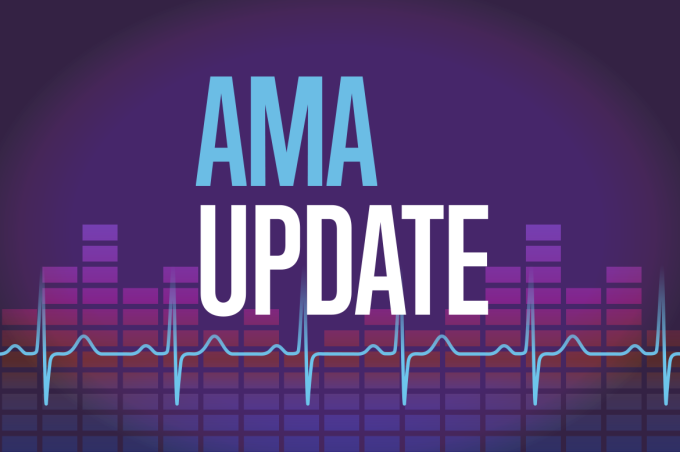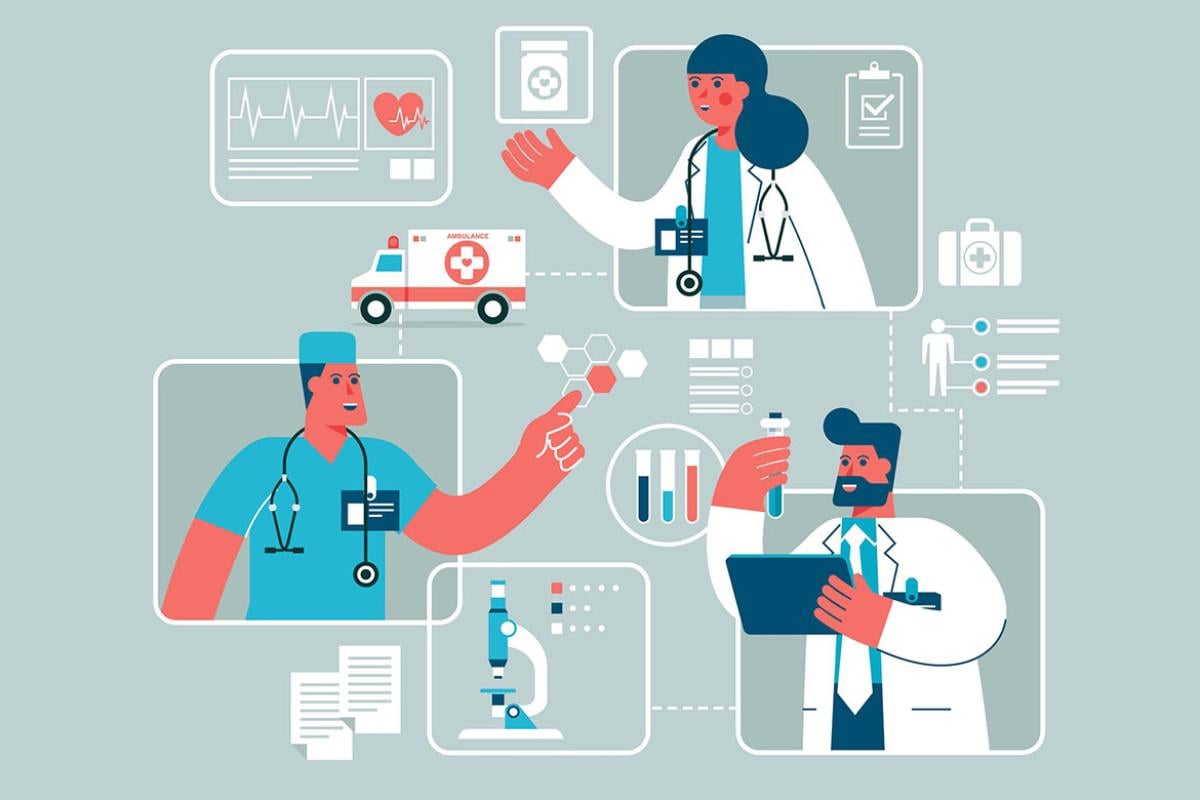AMA Update covers a range of health care topics affecting the lives of physicians, residents, medical students and patients. From private practice and health system leaders to scientists and public health officials, hear from the experts in medicine on COVID-19, medical education, advocacy issues, burnout, vaccines and more.
Featured topic and speakers
What are the best conferences on physician health? What is joy in medicine? Why are doctors burning out? What do doctors waste the most time on? Why doctors retire?
Our guest is Christine Sinsky, MD, vice president of professional satisfaction at the American Medical Association. In this episode, Dr. Sinsky reflects on her career at the AMA prior to her retirement and the lasting impact of her work to improve physician well-being. AMA Chief Experience Officer Todd Unger hosts.
- Watch AMA Update for health care news for physicians, residents and medical students.
- Not a physician? Join the Patients Action Network.
- Check out the AMA's STEPS Forward®.
- Explore AMA's Joy in Medicine™ Health System Recognition Program.
- Access the AMA Organizational Biopsy.
- Learn more on practice transformation and sustainability.
- 2025 American Conference on Physician Health.
- 2026 International Conference on Physician Health.
- The AMA is your powerful ally, focused on addressing the issues important to you, so you can focus on what matters most—patients. We will meet this challenge together. Join us.
- Learn more about our AMA advocacy priorities, including:
- Reforming Medicare payment
- Fighting scope creep
- Fixing prior authorization
- Reducing physician burnout
- Making technology work for physicians
Speaker
- Christine Sinsky, MD, vice president, professional satisfaction, American Medical Association
Transcript
Dr. Sinsky: If we invest a bit more in the delivery model, in intentionally developing the care environment, the staffing models, the scheduling systems, the physical spaces, the policies, the regulations. This whole idea of physician burnout, it's a fixable problem.
Unger: Hello and welcome to the AMA Update video and podcast. At the end of this month, the AMA's Vice President of Professional Satisfaction Dr. Christine Sinsky will be retiring. And today we're going to be talking with Dr. Sinsky about the lasting impact of her work and how it's changed the way that we think about and address physician burnout.
I'm Todd Unger, AMA's Chief Experience Officer. Dr. Sinsky, congratulations on your upcoming retirement. You're leaving behind such an incredible legacy at the AMA, and I'm excited to talk with you today.
Dr. Sinsky: Thanks, Todd. It's wonderful to be here with you.
Unger: Well, before we dive into your accomplishments—and there are a lot—how are you feeling about your upcoming retirement? And how did you decide that now was the right time?
Dr. Sinsky: Todd, I'm really feeling positive about it. I have loved working on these issues of improving professional satisfaction, practice sustainability, reducing burnout. And I'm really grateful to the AMA for having invested in the work and entrusted me to help lead it to this point.
But I really believe now is the time for someone with fresh ideas and different experiences to lead the work. And it's also, I think, time for me to experience this new phase. I'm guessing it will entail learning how to have a quieter mind, to find joy in living a smaller life. I'm looking forward to it.
Unger: Well, I know it must be bittersweet. It's probably hard to imagine back at a time when physician well-being really wasn't talked about as much. When you think back to when you joined the AMA, what was the conversation in medicine like around physician burnout and the stigma that was attached to it?
Dr. Sinsky: So if outside the AMA there was a focus at all on physician well-being within health delivery organizations, I think it was more focused on the resilience of individual physicians, yoga, mindfulness, that kind of thing, rather than improving the work environment for physicians and other health professionals. And that's changed over the years.
Unger: And that change is in large part due to you and your team's efforts because really that big shift was moving from the idea of it being an individual issue about resiliency. It was about making systemic changes that accounted for the bulk of what was driving burnout in the first place. Tell us more about that shift in how practice efficiency became such a key part of AMA strategy to reduce burnout.
Dr. Sinsky: Well, practice efficiency has always been my thing. Early in my practice, I realized that if I was going to be able to give good care, to be the wife I wanted to be, the mother I wanted to be, to keep my sanity, my team and I would have to be well organized and efficient.
And over the years, my nurses and I developed lots of workflows and approaches that did help reduce waste and rework. And I thought maybe some of that would end when my husband and I left clinical practice. But the good news is that isn't the case, that the AMA has really provided an opportunity to share.
Also, in fairness, there were many researchers ahead of me who also focused on systems causes and system drivers of burnout, researchers like Dr. Tait Shanafelt, who's now at Stanford, and Dr. Colin West and Lotte Dyrbye at Mayo. And I really want to shout out to the AMA because I think the AMA has been ahead of its time. Even back just before I joined the AMA, there was already an advisory panel on physician career satisfaction. And that group sponsored a study that was carried out by the RAND Corporation that found that the major driver of physician career satisfaction was the ability to deliver high-quality care.
Well, to do that, you need good practice efficiency. You need good teamwork. So now, one of the missions at the AMA is to reduce barriers to delivering such high-quality care. And improving well-being is a part of that.
Unger: Now, you had this experience through your own practice about improving workflows to drive practice efficiency. Did it surprise you as you began to conduct research into, I guess, the extent to which these system-level problems were driving burnout versus other possible options?
Dr. Sinsky: So one of the things that happened as I started to get engaged in national organizations and I started to visit practices as part of a research project that I led called "In Search of Joy in Practice." I was really astounded at how different practices were structured than what had evolved in my own practice and how much time physicians were spending on tasks that really didn't require a medical school education. And to me, a medical school education is a terrible thing to waste. And I saw that happening for colleagues in many different settings.
Unger: When I think of a lot of the work you've done, things pop into my head like improvements in inbox management, prescription refills, things that seem mundane, logins to the EHR, but when added up, we're taking so much time and really causing a lot of frustration. Again, any highlights to your learnings in these areas?
Dr. Sinsky: So I think that when you're in the thick of it and when it's what you've always known, it's hard to recognize all those minutes here and minutes there that add up to a lot of waste. And so I'll tell you, I had to highlight even just this morning. Several other physicians and I were meeting with a group from the University of Iowa. And they have implemented advanced team-based care. And they've implemented focused on previsit planning, focused on empowering their team to do more of the tasks so the physician can spend their time doing physician-level work. And since I practiced in Iowa, 15 years ago I visited Iowa a different set of people to now see them having on their own using STEPS Forward toolkits develop this model, it was fun. It was great.
Unger: That must feel really good to see your impact there across so many different areas. I was just thinking of another piece of research that feels so seminal now as we look back, which was really understanding how much work physicians were taking home with them as a result of everything they had to do during the day. Any other kind of highlights to you of things that you've learned through this process?
Dr. Sinsky: So I've really felt like our Joy in Medicine recognition program and our ability to help organizational leaders assess their care environment through our assessment tool, which we call our Organizational Biopsy, those, along with the STEPS Forward tool kits, which give actionable guidance as to what to do with those assessment results and how to meet the Joy in Medicine recognition program criteria, I put those three things up as key highlights.
Unger: That's a huge highlight, and let's talk a little bit more about the AMA Joy in Medicine Health System Recognition Program, which started, I guess, 2019. It really did help establish AMA as a leader in physician well-being, and it's really brought some much needed recognition to health systems that are really taking big steps forward, pardon the pun, to really improve the situation for their physicians. Why do you think this program's been so well received?
Dr. Sinsky: I think it's been well received because it fit a need. Back in 2017, Dr. Shanafelt and I came up with this idea, what if we created a recognition program with criteria that could serve as a roadmap? Because we'd heard over and over again from CEOs and other leaders, OK, you've got our attention. We know we've got a problem. We know we have to deal with it. But what should we do?
And so we developed these criteria that have in fact served as a roadmap, both for organizations who are applying for recognition and even for organizations that aren't yet ready. We know many organizations have structured their systems activities around our six domains of activity so that even those who aren't applying for recognition are benefiting from the guidance, the roadmap.
Unger: When you started it, did you think that you would be looking at over 150 organizations across the country being recognized since its inception and record-breaking growth in terms of applications?
Dr. Sinsky: We had no idea, as with many things that we've done in the last 10 or 12 years, how it would develop. And I'm so grateful to our team, to the AMA, to the people who've given us additional input. As you said, we currently recognize—we've recognized over time 150 organizations. Thirteen of the 15 largest health systems have participated in the program and earned recognition at either the bronze, silver or gold level. We've really touched organizations where hundreds of thousands of physicians are currently working. We're not done yet. And even organizations that are recognized aren't done with their work, but they're on the journey.
Unger: What a huge accomplishment. It also might surprise people to know that bringing people together to discuss the topic of burnout was also relatively new in your tenure. The International Conference on Physician Health started to focus on this in 2010, and then in 2017, you helped create the American Conference on Physician Health. How have conferences like that continued to impact medicine today?
Dr. Sinsky: So I think both the International and the American Conferences on Physician Health have been really instrumental in growing and maturing the field of health professional well-being. And there's this great opportunity for networking, for meeting colleagues, for just sharing some of the enthusiasm for this work. It's a time when researchers share their research, but also operational leaders come and share some of the innovative practices.
There's so many creative and effective approaches across the country and across the globe to learn from. And I think this really enthusiastic, maybe overstating it, almost spiritual experience of coming to ICPH and ACPH is why it's grown so. In our first year, we had about 400 participants, and it's grown ever since. So ACPH in 2023 had 600 participants. Last year for ICPH, we sold out within hours. And so this year, for ACPH, the fifth ACPH in our history, we're expecting around 750 participants. I encourage anyone who's interested to register as soon as they possibly can because of how quickly it sold out last year. Registration opens on June 2, and the conference itself is in Boston, September 11 through the 13.
Unger: All right. So make sure to act quickly because that is in high demand. Dr. Sinsky, clearly there's been so much progress on physician being over the past decade. The numbers from our latest research show continuing improvements. But as you pointed out, still more work to do. How do you see the future in terms of physician being and burnout? And what do you see about the AMA's work in terms of its evolution?
Dr. Sinsky: So I think there's two major focus areas that we can dive even further into. One is the connection between physician well-being and other outcomes that organizational leaders care about and that national leaders care about. So there's a good correlation between physician well-being and the quality of care that patients experience. We've got solid research on this, but we can expand that research further.
Likewise, there's good evidence that physician well-being impacts the cost of care for individual patients, for the payers, for the health care system writ large. But that too can be strengthened. And then I think what we really need to do is strengthen our messaging to leaders outside of the well-being space so that CMOs, CFOs, CEOs really see how focusing on the well-being of the workforce is a gateway to meeting their other objectives.
I often say, if you care about patient safety, you have to care about burnout. If you care about keeping your organization solvent, you have to care about burnout. So I think it's just a focal point, and we need to have even more research and more communication available for that.
Unger: That makes so much sense, and that connection that you're drawing there between patient care and the well-being of the workforce is so important. Dr. Sinsky, we've talked a lot about how your legacy and your work has impacted others. I'm just curious, personally, how has this impacted your own work? And what are you going to take away from it?
Dr. Sinsky: Well, I've just been so fortunate to close out my career as a physician working to help my colleagues find joy in their work as they seek to serve others. And I think that's what I'll take away from it. I was fortunate to practice clinically for 32 years and then to do this work over the last 12 years. It's been a nice capstone to my career, and I'm grateful to the AMA for that.
Unger: Well, before we go, do you have any final words of wisdom that you'd like to share?
Dr. Sinsky: Sure. I think, in this country, we've historically invested billions of dollars every year researching new tests and treatments. And I'm glad we have done this. Physicians never before have been able to do so much good for our patients with these technological advances and medication advances.
And I think if we invest a bit more in the delivery model, in intentionally developing the care environment, the staffing models, the scheduling systems, the physical spaces, the policies, the regulations. This whole idea of physician burnout, it's a fixable problem. And I think as we put more and more energy into that, patients, physicians and our teams will thrive.
Unger: Dr. Sinsky, thank you so much for everything you've done to improve the well-being of physicians, and congratulations again on your retirement.
Dr. Sinsky: Thanks, Todd.
Unger: Fighting to reduce physician burnout is one of the top priorities of the AMA. And to support our work, we encourage you to become an AMA member at ama-assn.org/joinnow. And to learn more about the AMA Joy in Medicine Program, you can visit ama-assn.org/joy. That wraps up today's episode. We'll be back soon with another AMA update. Be sure to subscribe for new episodes and find all our videos and podcasts at ama-assn.org/podcasts. Thanks for joining us. Please take care.
Disclaimer: The viewpoints expressed in this video are those of the participants and/or do not necessarily reflect the views and policies of the AMA.




